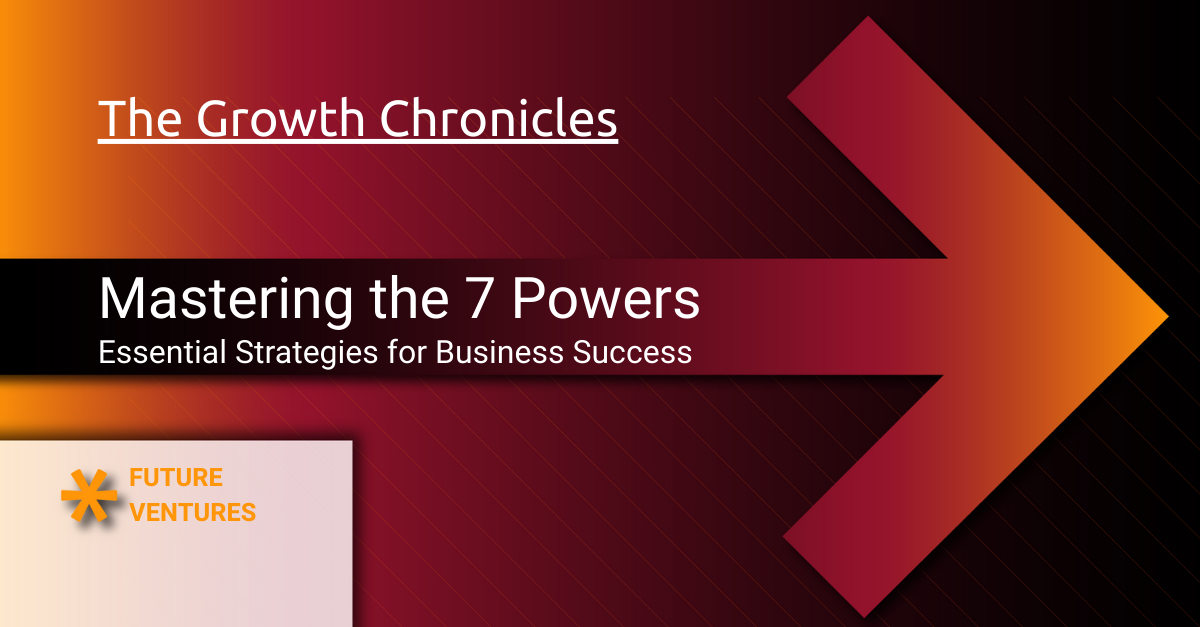Vesting: The Scale-Up Founder’s Guide to Equity, Alignment and Retention
The Scale-Up Imperative: Building a Repeatable, Scalable Business Model
In a world where capital is fluid, loyalty is fleeting, and talent is mobile, equity has become the ultimate alignment mechanism.
You can pay people to show up. But you can’t pay them to care. Vesting changes that.
Vesting turns ownership into commitment. It transforms “I work for you” into “I build with you.” Vesting keeps employees focused on the company’s long-term success by aligning their interests with the achievement of key milestones and the company’s overall growth. Vesting schedules are specifically designed to encourage loyalty by motivating employees to remain committed to the company's success.
And for scaling founders, it’s not just a legal construct; it’s a strategic instrument that shapes your company’s growth architecture, your culture, and your ultimate enterprise value. The importance of vesting lies in its ability to foster a culture of ownership and drive business growth, especially during the critical scaleup phase.
At Future Ventures, we treat vesting as a founder’s control mechanism, not an HR policy. It’s where finance, psychology, and governance intersect to create long-term resilience.
1. Understanding Vesting: Ownership on a Clock
At its simplest, vesting refers to earning the right to an ownership stake or benefit over time or upon achieving a milestone. It’s the when and how of ownership. The vesting period is the course over which rights are earned, typically structured so that a portion of ownership vests over several years. Common vesting periods are three years or five years, depending on the plan. Vesting requires employees to work for a company for a specified term of years to gain ownership rights to certain assets or benefits. Once a retirement plan is fully vested, the employee has an absolute right to the entire amount of money in the account. Various vesting schedules, such as cliff vesting and graded vesting, are grounded in theory about how to incentivize employee retention and manage contributions.
You don’t hand someone the keys to the kingdom on Day 1. You let them earn those keys: one milestone, one year, one contribution at a time.
The Core Equation
| Component | Description | Founder Implication |
|---|---|---|
| Grant | The initial promise (equity, options, RSUs, tokens). | Sets the incentive baseline. |
| Vesting Schedule | The timeline or milestones for earning ownership; employees are subject to the vesting schedule's terms. | Defines retention horizon. |
| Cliff | The minimum time before any equity is earned. | Protects against false starts. |
| Exercise Period | The window for converting options to shares. | Manages post-employment control. |
| Forfeiture | Forfeiture is what happens to unvested equity if an employee leaves the company early. The unvested equity is forfeited upon early departure. | Prevents equity leakage. |
This structure is the foundation of your Equity Architecture: the system that converts financial promise into behavioural loyalty.
2. Why Vesting Exists: Protection and Alignment
- For Founders: Vesting protects your cap table. It ensures that equity remains a reward for contribution, not a relic of past involvement. Without it, you risk having “dead equity”: ownership held by people who’ve long stopped contributing value.
- For Employees: Vesting creates a sense of trajectory. Each month, quarter, or milestone brings them closer to a tangible goal. Equity becomes an instrument of belonging, not just a benefit buried in an offer letter.
- For Investors: Vesting de-risks capital. It ensures that ownership and effort are proportionally aligned across time. No investor wants to fund a company where 20% of shares belong to a departed co-founder who left 18 months in.
⚡Provocation: If your team could walk away tomorrow and still own 20% of your company, you’re not building a business; you’re sponsoring a lottery.
3. The Three Pillars of Vesting
A. Time-Based Vesting
The most common form. Ownership accrues gradually: usually over 3–4 years.
This is the
“marathon model.”
Example: You offer a key hire 1% equity stake over four years, with a one-year vesting cliff.
- At month 12, 25% vests (the cliff).
- After that, 1/48th vests monthly until the four-year mark.
Why it matters: It stabilizes your leadership horizon. You’re essentially saying, “If we’re still building together in 48 months, you deserve a piece of what we’ve created.”
B. Milestone-Based Vesting
Ownership is tied to outcomes, not time.
This is the
“performance model.”
Example: A CTO’s equity vests when the MVP ships, the system scales to 10,000 users, and Series A is closed.
Why it matters: This model drives velocity, but it also risks burnout if milestones are poorly defined or outside the individual’s control.
⚡Rule of Thumb: Time-based vesting builds stability. Milestone-based vesting builds urgency. Hybrid builds alignment.
C. Hybrid Vesting
A combination of both. Common in founder agreements and executive incentive plans.
Example: 50% vests over four years (time-based), and 50% vests when EBITDA hits $10M or a Series B is achieved.
This approach keeps the team anchored to both duration and direction.
D. The Equity Alignment Framework: Maximizing Impact Through Tailored Vesting
The right vesting model is a powerful lever for aligning incentives, retaining talent, and driving company success. Choosing between time-based, milestone-based, or hybrid vesting depends on your company’s stage, culture, and strategic priorities.
| Vesting Type | Best For | Risk | Example |
|---|---|---|---|
| Time-Based | Core team | Complacency | Early hires & senior staff |
| Milestone-Based | Project delivery | Unrealistic targets | Engineering, product teams |
| Hybrid | Founders & execs | Complexity | Founder agreements, growth- |
- Time-Based Vesting offers steady and predictable ownership accrual, fostering long-term commitment and stability. It’s ideal for roles where sustained contribution over several years is critical.
- Milestone-Based Vesting accelerates ownership tied to achievement, motivating teams to hit key deliverables and fueling rapid progress. However, it requires clear, attainable goals to avoid frustration.
- Hybrid Vesting blends the best of both worlds, anchoring employees to the company through time while rewarding exceptional performance with milestone triggers. This approach is especially effective for founders and executives who drive both day-to-day operations and strategic breakthroughs.
By aligning vesting schedules with individual roles and company objectives, founders can create a culture where ownership feels earned and meaningful, ultimately encouraging loyalty and accelerating growth. This strategic use of vesting transforms equity from a simple reward into a dynamic tool for scaling success.
4. The Cliff: Your Safety Mechanism
Think of the cliff as your startup’s trial period; but with equity implications.
A one-year cliff means no one earns ownership until they’ve proven commitment. If they leave or underperform before then, they walk away empty-handed. Employees can lose unvested benefits if they leave the company before the vesting schedule is complete, especially with cliff vesting.
Why it matters:
It filters tourists from believers. It signals seriousness that equity is earned, not gifted.
Typical Cliff Structures:
- Founders: 12 months
- Employees: 6–12 months
- Advisors: 6 months or milestone-based
Pro Tip ⚡: Never waive the cliff for “strategic hires.” If someone insists on day-one ownership, they’re optimizing for upside, not impact.
5. Vesting as a Strategic Weapon
Vesting is not paperwork. It’s a governance tool. When used well, it aligns your Enterprise Value Map across three dimensions:
| EVM Dimension | Vesting Function | Strategic Outcome | Founder Question to Ask | Future Ventures' EVM Reference |
|---|---|---|---|---|
| Talent Leverage | Uses equity as a retention and motivation engine that compounds over time. | High-value talent remains engaged through earned ownership. | “Does my vesting structure make people stay for the mission or for the money?” | Human Capital & Capability Quadrant — EVM Axis 1 |
| Financial Leverage | Controls dilution through staged ownership; defers cash while preserving capital runway. | Lower burn rate, cleaner capitalization tables, and investor confidence. | “Am I trading equity for contribution or convenience?” | Capital Structure & Funding Quadrant — EVM Axis 2 |
| Operational Leverage | Aligns compensation timelines with product, revenue, and operational milestones. | Predictable execution rhythm; fewer incentive clashes between departments. | “Does my vesting clock tick in sync with my operating model?” | Processes & Systems Quadrant — EVM Axis 3 |
| Governance Leverage | Establishes transparent rules of ownership and exit; prevents equity drift. | Reduced board conflict, smoother succession, and legal defensibility. | “Would my governance survive if a co-founder left tomorrow?” | Governance & Risk Quadrant — EVM Axis 4 |
| Cultural Leverage | Translates equity into belonging; turns employees into stakeholders. | Deep sense of shared accountability; equity becomes identity. | “Does everyone here feel like they own part of the story?” | Leadership & Culture Quadrant — EVM Axis 5 |
Effective vesting structures can help companies successfully cross the growth chasm by retaining key talent and aligning interests during periods of rapid expansion.
Your vesting schedule is your operating system for loyalty. Every startup culture is shaped by its equity structure.
How to Use This Table
Map your current or planned
vesting schedule against each
Enterprise Value Map dimension above.
For every dimension scoring
below 3 / 5 in alignment, identify corrective levers—adjust duration, cliff, or milestone definitions to close the gap.
👉 Refer to the Enterprise Value Map model on www.futureventures.ca/enterprise-value-map for visual alignment templates and scoring rubrics.
6. The Human Psychology of Vesting
People don’t work harder because of stock options. They work harder because those stock options make them feel like owners. Vesting serves as a tool for employee retention by providing employees with ownership rights only after a specified period of service.
But ownership is psychological before it’s financial. A 0.5% equity grant can mean nothing or everything depending on how it’s communicated.
The companies that get this right build cultures of ownership, not entitlement.
Story: The Airbnb Reset
When Airbnb hit turbulence in 2020, Brian Chesky restructured equity around impact vesting, focusing on contributions to recovery milestones rather than tenure. That move rebuilt internal confidence faster than any cash injection could.
⚡Key Insight: Vesting isn’t about time served. It’s about value created.
7. Designing Your Vesting Architecture
When you design your vesting plan, think like an architect, not an accountant. Companies often offer grants of common stock or stock options as part of their compensation plans, providing employees with access to ownership opportunities and aligning their interests with the company’s growth. Every clause sends a message about your culture and your values.
Identifying opportunities for collaboration and growth is crucial when designing vesting plans, as it ensures alignment between company objectives and employee goals, and helps realize win-win outcomes for all stakeholders.
Step 1: Define Objectives
- Do you want retention, performance, or both?
- Are you optimizing for control or culture?
- Who must never leave (founders, CTO, commercial lead, critical job roles)?
Step 2: Choose Your Vesting Model
- Time-based for stability
- Milestone-based for velocity
- Hybrid for strategic alignment
Step 3: Set Vesting Period Duration and Cliff
- 4 years with a 1-year cliff is standard for startups
- 3 years with a 6-month cliff for scale-ups in fast-moving markets
Step 4: Establish Post-Termination Rules
- 90-day exercise windows are too short for many employees. Consider 6–12 months for senior roles to show goodwill. The entire option to purchase stock is lost if not exercised within a short period after the end of the employer relationship.
Step 5: Communicate Transparently
Make vesting part of your story, not the fine print.
The best founders explain it like this:
“We don’t give equity. We lend belief and we make it permanent when you’ve earned it.”
8. International and Legal Considerations (Keep It Simple, Keep It Safe)
If you operate across borders, the taxation and enforceability of vesting vary dramatically.
- U.S. (Delaware C-Corps): Standard 4-year vesting with 1-year cliff, clear 409A valuation structure. Employer contributions to retirement plans are often subject to vesting schedules, determining when employees gain full ownership of employer-contributed funds or stock bonuses.
- Canada: Employee Stock Option Agreements (ESOAs): taxation at exercise, not grant.
- Europe: Often tied to local labor laws; can trigger taxable events earlier. In some jurisdictions, vesting rights may be affected by life events such as death, and life interests or estates can impact how benefits are distributed.
- Remote Teams: Always anchor vesting jurisdiction at the HQ or holding company, not the employee's residence.
Acquisition events, such as company sales or mergers, can trigger accelerated vesting or changes to vesting schedules, and should be considered in legal planning.
⚡Future Ventures Principle: You can’t scale chaos. Align legal, financial and emotional incentives under one roof.
If uncertain, consider using equity management software (such as Carta, Pulley, or LTSE Equity) for precision and transparency.
9. The Founder’s Dilemma: When Vesting Backfires
Sometimes, vesting creates friction instead of alignment.
The top three mistakes we see:
| Mistake | Consequence | Fix |
|---|---|---|
| Over-generous grants early on | Dead equity; lack of future flexibility | Start small, scale with milestones |
| No re-vesting after funding rounds | Co-founders misaligned post-Series A | Re-paper founder agreements every 24–36 months |
| Ignoring vesting on advisors/contractors | Equity leakage | Use milestone-based vesting for all non-employees |
⚡Remember: The only thing harder than granting equity is taking it back.
10. Vesting and the Operational Leverage Stack
Vesting isn’t an HR construct; it’s a leverage mechanism inside your Operational Leverage Stack (OLS). Startup companies often utilize vesting to align interests during the early development and investment phases, providing stock options and equity grants to employees and key stakeholders.
In more mature companies, vesting can apply not only to retirement plans but also to stock options and other forms of employee compensation.
Employees contribute a percentage of their paycheck to their registered or unregistered plan, and their employer may match part or all of that contribution.
Matrix: Operational Leverage Stack - Equity Layer Integration
| Leverage Layer | Role | Example |
|---|---|---|
| Human Leverage | Talent retention through ownership | Key hires vest over 4 years |
| Financial Leverage | Controlled dilution and deferred compensation | Equity > salary in early stages |
| Governance Leverage | Institutionalizes accountability | Vesting tied to KPIs and board approval |
| Cultural Leverage | Embeds a sense of “earned ownership” | “We build this together” mindset |
⚡Key Insight: When your vesting system connects to all four, you move from equity sharing to equity strategy.
11. Vesting in the Next Decade: The Future Ventures' 2030 View
By 2030, vesting will evolve beyond time and milestones, driven by ongoing innovation and learning. Future vesting models will adapt as companies accumulate knowledge and respond to new challenges, ensuring founders and teams stay ahead in a rapidly changing environment.
| Emerging Trend | Description | Implication for Founders |
|---|---|---|
| Dynamic Vesting | Smart contracts that adjust vesting pace based on contribution or revenue targets. Dynamic vesting will support companies aiming to build a repeatable and scalable business model, helping them transition from startup to scale-up. | Increased personalization, less manual oversight. |
| Tokenized Equity | Hybrid models that combine equity and on-chain tokens for enhanced liquidity and transparency. | Blurred lines between ownership and reward. |
| Behavioral Vesting | AI tools that track engagement, performance, and collaboration to trigger vesting events. | Greater meritocracy, potential privacy trade-offs. |
| Collective Ownership Models | Vesting applied across ecosystems (partners, creators, customers). | New brand loyalty dynamics. |
⚡Key Insight: The future of vesting isn’t legal; it’s algorithmic. Ownership will be earned, measured, and distributed by data; not documents.
12. Final Takeaway: Vesting as a Founder's Superpower
When you design a vesting plan, you’re not dividing the "pie"; you’re building gravity.
Every vesting schedule you create pulls people closer to your mission.
It’s how you turn compensation into conviction.
And when done right, vesting becomes your most scalable trust mechanism. The invisible force aligns founders, employees, and investors behind a shared narrative of growth.
⚡Key Insight: Vesting isn’t about ownership. It’s about belief, endurance, and alignment. The currency of scale.
About Future Ventures Corp.
Future Ventures Corp. is a scale-up advisory and strategy firm based in Alberta, Canada. We help founders, CEOs, and business owners transform complexity into clarity through frameworks such as the Enterprise Value Map, Operational Leverage Stack, and Governance Guardrails Framework, driving measurable enterprise value creation and leadership alignment across scaling companies.
About the Author: Maxim Atanassov
Maxim Atanassov is a 4x founder, scale-up advisor, and former Big 4 consultant. He leads Future Ventures Corp., working with boards and founders across North America to modernize governance, optimize capital structures, and accelerate enterprise value growth. His work blends financial rigour with human insight and a relentless belief that the next decade belongs to those who scale with alignment.










